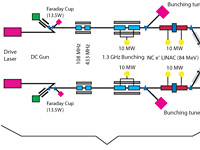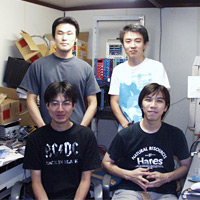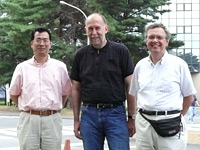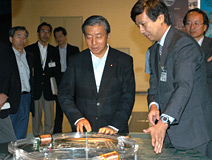Gone in 20 Picoseconds

A schematic of the polarised electron source for the ILC. |
Imagine that you are given roughly three months to complete a project. Then your boss comes in and asks if you can speed things up – not by just a couple of weeks or even months. You have precisely 100 times less than your original deadline, squeezing the amount of time in three months down to one day. Picture yourself in this situation, and you will have a renewed respect for the massive requirement of the electron source R&D group for the International Linear Collider – shortening the electron pulses from two nanoseconds to 20 picoseconds.
Read more...
-- Elizabeth Clements |
|
 |
The Future of Photon Sensors

Standing L-R: Yuji Sudo, Hideki Yamazaki. Sitting L- R: Satoru Uozumi, Takashi Maeda. |
As part of the Global Large Detector – Calorimetry (GLD-CAL) Collaboration, a group of researchers from the University of Tsukuba spent their summer developing a new photon sensor for the GLD calorimeter. Because the photon sensor that the GLD currently uses is costly and very large in size, GLD-CAL had the task of finding a more optimal photomultiplier for the calorimeter. After a summer of research, the group from the University of Tsukuba believes that a Multi Pixel Photon Counter (MPPC) is the answer.
Read more...
-- Nobuko Kobayashi |
 |
|
|
 |
From Scientific American
28 August 2006
What are dark matter and dark energy, and how are they affecting the universe?
Dark energy and dark matter describe proposed solutions to as yet unresolved gravitational phenomena. So far as we know, the two are distinct.
Read more... |
|
From Seed Magazine
25 August 2006
Scientists Confirm Dark Matter's Existence
Scientists offered powerful confirmation of dark matter this week, after observing a collision of galaxies in the so-called bullet cluster.
Read more... |
|
From Beam Dynamics Newsletter
No. 40, August 2006
The Baseline Configuration for the ILC (By Barry Barish)
Very recently we have
obtained cost information on the various subsystems and technical systems and we are
now focussing on re-examining various choices in the baseline to optimize cost to
performance.
Read more... (pdf) |
|
|
 |
Why Cost Confidentiality?

The three cost engineers Tetsuo Shidara (KEK), Wilhelm Bialowons (DESY) and Peter Garbincius (Fermilab) at KEK this week. |
A central focus of the GDE at this time is determining the ILC cost in its present form. Over the next few months we will be doing selected studies to optimise the cost to performance. We have identified and are studying potential design changes, which in some cases will lead to proposals to our change control board, who will evaluate the benefits and risks and make a recommendation. Through this process we will shape the present ILC concept into the design we will eventually present in our Reference Design Report. As a result, I will write about various studies and design changes over the coming months, and I should begin today by discussing cost confidentiality: why it is necessary, and how this will limit what I can and cannot share.
Read more...
-- Barry Barish
Director's Corner Archive |
 |
|
|
 |
|
ILC-Related Preprints
hep-ph/0608255
30 August
Collider searches and cosmology in the MSSM with heavy scalars
hep-ph/0608227
21 August
Signals of Universal Extra Dimension at the ILC
physics/0608135
12 August
On Field Emission in High Energy Colliders Initiated by a Relativistic Positively Charged Bunch of Particles |
|

Trying out a model accelerator in the KEK exhibition hall, Kenji Kosaka, Japanese Minister of Education, Culture, Sports, Science and Technology, visited KEK on 30 August.
|
|

